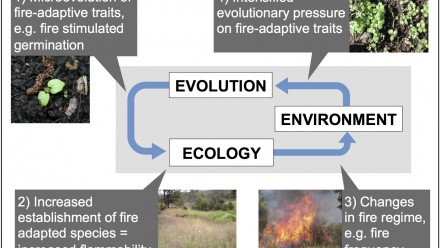Can adaptation in ‘ecosystem engineers’ drive fire regime feedbacks?
Ignition Grant Round 5 (Sept 2015)
Annabel Smith, Justin Borevitz, ANU; Shannon Dillon, CSIRO
This project aims to determine whether adaptation in invasive plant species contributes to changing fire regimes.
Contemporary shifts in fire regimes driven by invasive species, land use and climate change are occurring globally and this can push fire regimes beyond their historical range of variability. The current mismatch between past and present fire regimes means we have little ability to predict how, or if, ecosystems will adapt to these novel pressures.
There is ample evidence that invasive plant species can rapidly adapt to new environments but no studies have yet examined rapid evolution of fire-adaptive traits (e.g. fire-stimulated germination) in invasive species. This is surprising considering that invasive species can be ‘ecosystem engineers’: plant species that influence biotic processes by modifying the abiotic environment.
Invasive species can alter fire regimes by changing fuel properties, resulting in a positive fire regime feedback where the invasion process accelerates fire frequency and/or intensity increases.
This project will investigate if adaptation in invasive species can reinforce changes in fire regimes by increasing the persistence of fire-tolerant or fire-promoting lineages. We will initiate the project with a review paper to address the question: Can adaptation in invasive ‘ecosystem engineers’ drive fire regime feedbacks?
Funding from the CBA will kick-start this new ANU-CSIRO collaboration between Dr Annabel Smith, Professor Justin Borevitz and Dr Shannon Dillon and allow Dr Smith to produce a review paper and in-kind contributions from RSB will be used to determine if adaptation to fire regimes in invasive species is faster when genomic diversity originates from multiple source populations than from a single source.
The review paper will form the basis of a more substantial landscape genomics research project investigating whether fire regimes drive phenotypic and genomic divergence between native and introduced populations within species.
We will compile species lists from major invasive species databases (e.g. Global Invasive Species Database) and characterise fire regimes of invaded habitats. Trait data will be gathered from the TRY online global plant trait databaseand species will be grouped by fire-adaptive traits: regeneration strategy (resprouter/seeder), serotiny, heat and smoke stimulated germination and flammability. We will use these existing data to determine if certain traits make a species more likely to invade fire-prone ecosystems and contribute to fire regime feedbacks. This analysis will form the core of a review paper on adaptation in ecosystem engineers, with a specific focus on its role in driving fire regime changes.
We will then characterise gene flow across the Australian range of two phylogenetically independent invasive plant species: Cytisus scoparius Fabaceae (Scotch Broom) and Hypericum perforatum Clusiaceae (St John’s wort). Single-nucleotide polymorphism matrices will be generated using genotyping-by-sequencing. We will use spatial genetic analyses to identify hybrid zones with sufficient background genomic variation across fire regime gradients (e.g. 0-6 fires in the past 100 years) that would enable rapid adaptation through transgressive segregation, beyond the phenotypic distribution of the founders.
This new project leverages existing expertise and funding in the CBA on plant genomics for climate adaptation. Drawing on this framework, our new project focusses on changes in fire regimes as drivers of plant adaptation. We will capitalise on specialised world-class equipment at ANU including image-based phenotyping greenhouses, sample preparation robotics and very high throughput genome sequencing machines. Our project’s international advisory committee brings complementary strengths in evolutionary fire ecology (Dr Pausas, Spanish National Research Council) and invasive species biology (Professor Buckley, Trinity College Dublin).
Our project will add a new dimension to CBA research by expanding our understanding of the role of fire in driving plant adaptation under global change.
This project has strong potential for direct contributions to public policy in the areas of Climate Change and Adaptation, Habitat fragmentation and Restoration and Invasive Species and Biosecurity. Fire regime changes have serious consequences, causing biodiversity declines, irreversible changes in ecosystem function and threats to human life and property which must be managed at a huge public expense.
Currently, prescribed fire is used as an ecosystem management tool to reduce fuel loads. However, if fire assists plant invasion, traits that promote fire-tolerance or flammability could be selected for under increasing fire frequency. Reducing prescribed fire in areas where invasive species dominate could reduce the risk of further invasion while also saving management costs. This project could therefore challenge the way we think about, and manage, fire regimes in Australia. This will be essential progress towards conserving Australia’s biodiversity and managing risks to human communities under rapid global change.
2016 Progress Report
- 400 samples have been collected of the two target invasive plant species (Hypericum perforatum and Cytisus scoparius) across fire frequency gradients in Victoria and NSW.
- GBS libraries have been constructed in the Borevitz lab, which were sequenced at the ACRF Biomolecular Resource Facility (BRF).
- Preliminary analysis identified > 3000 SNPs per species and further population genetics analysis is underway. The data and/or sample taxonomy wasn't what we expected - it may be likely that there have been multiple introductions or cryptic species.
- AS (currently based at Trinity College Dublin) has submitted applications for further funding to sample individuals in their native range across Europe. This will allow us to identify the sources of the Australian samples and determine if genomic variation is related to fire history and other environmental variables.





